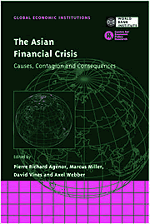Book contents
- Frontmatter
- Contents
- List of figures
- List of tables
- Preface
- List of conference participants
- Acknowledgements
- List of abbreviations and acronyms
- Introduction
- Part One General Accounts
- 1 The role of macroeconomic and financial sector linkages in East Asia's financial crisis
- Discussion
- 2 The Asian crisis: lessons from the collapse of financial systems, exchange rates and macroeconomic policy
- Discussion
- 3 Are capital inflows to developing countries a vote for or against economic policy reforms?
- Discussion
- 4 The Asian crisis: an overview of the empirical evidence and policy debate
- Discussion
- Part Two Theoretical Contributions
- Part Three Contagion
- Part Four Policy Responses
- Index
2 - The Asian crisis: lessons from the collapse of financial systems, exchange rates and macroeconomic policy
from Part One - General Accounts
Published online by Cambridge University Press: 26 February 2010
- Frontmatter
- Contents
- List of figures
- List of tables
- Preface
- List of conference participants
- Acknowledgements
- List of abbreviations and acronyms
- Introduction
- Part One General Accounts
- 1 The role of macroeconomic and financial sector linkages in East Asia's financial crisis
- Discussion
- 2 The Asian crisis: lessons from the collapse of financial systems, exchange rates and macroeconomic policy
- Discussion
- 3 Are capital inflows to developing countries a vote for or against economic policy reforms?
- Discussion
- 4 The Asian crisis: an overview of the empirical evidence and policy debate
- Discussion
- Part Two Theoretical Contributions
- Part Three Contagion
- Part Four Policy Responses
- Index
Summary
Introduction
The East Asian financial crisis plunged the most rapidly growing and successful economies in the world into financial chaos and deep depression. At the time of writing, 18 months from its onset, neither the events them selves nor the appropriate policy responses are properly understood; but the outlines of a picture are becoming clear.
We see the Asian crisis – as many others do – as the outcome of a flawed process of financial liberalisation. But the trouble with that diagnosis is that it has often been served up accompanied by a rather loose list of mistakes, and buttressed by no very clear argument. Accordingly, the question which we set ourselves is a precise one: why was the crisis so bad? In other words, why did ‘crisis’ turn into ‘collapse’? Our answer to this question is that it was because of the inter-relationship between currency crises and financial crisis. Our argument proceeds in four stages, which are set out schematically in figure 2.1.
(1) We argue that vulnerability was created both by liberalisation in the presence of a bank-based financial regime (which contained implicit promises of bail-out if its balance sheet deteriorated), and by liberalisation in the presence of a monetary policy regime based on pegged exchange rates (which led to boom and bust). These vulnerabilities were interconnected, and led to a risk of currency and financial collapse (levels 1 and 2 in figure 2.1).
[…]
- Type
- Chapter
- Information
- The Asian Financial CrisisCauses, Contagion and Consequences, pp. 67 - 110Publisher: Cambridge University PressPrint publication year: 1999
- 9
- Cited by



